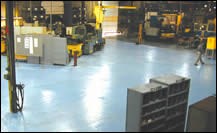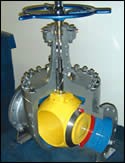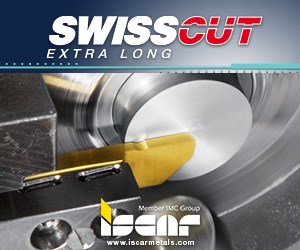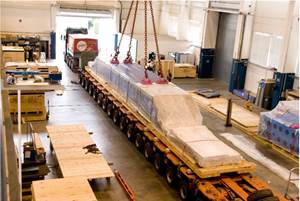The Technology Of Lean Machining
This plant makes different choices for its machining cells depending on whether the parts to be machined there are known or unknown.
"If you manufacture a product in the United States, then it better be engineered to order or else problematic to ship."
That's the assessment of Lyle Williams, senior plant manager for the Cooper Cameron Valves plant in Little Rock, Arkansas. The "Orbit" brand valves manufactured here for pipeline applications are much bigger than what a man can lift . . . and yet they are not so big that an overseas producer could not make and ship some mass-produced standard model more cheaply than this plant could. That leaves engineering to order as the advantage that lets this U.S. plant manufacture competitively.
Today, 40 percent of the plant's output fits that description. "Engineered to order" refers to a product that is different from what the plant has made before because it was designed for the needs of just one customer.
Another 20 percent of what the plant makes is "made to order." Valves fitting this description are made from existing designs, but they are produced and delivered on such short notice that the plant has no way to anticipate demand.
Only the remaining 40 percent of the plant's output consists of standard valves for which the demand is known in advance or is at least safely predictable. The amount of this predictable production of standard products is small compared to the amount of this work in other plants, but still it is large enough to be significant. Therefore, when the Little Rock plant made its transformation to lean manufacturing, it was faced with two distinct challenges.
One was how to streamline production for a product that has a known design, and a demand that is sometimes known as well.
The other challenge was how to streamline production of the unknown.
The Role Of Technology
The differences between the plant's responses to these two challenges are apparent in choices made on the production floor. Specifically, machining cells are equipped in fundamentally different ways, depending on whether they machine known or unknown parts.
Often a plant's transition to lean production does not focus on the choice of equipment, but instead is more likely to be concerned with the procedures that determine how the existing equipment is used. For Cooper Cameron, the question of how to deploy existing equipment proved to be more relevant to the challenge of unknown parts. For leaner machining of more predictable parts, the plant was able to justify improving its technology by purchasing and outfitting two new eight-pallet flexible manufacturing systems from Toyoda Machinery USA (Arlington Heights, Illinois).
Any discussion of shopfloor equipment and technology has the danger of implying that the equipment alone determines success. Conversations with various managers at the Little Rock plant all highlight the extent to which this is not the case. Last year, an analysis of the markets this plant serves revealed some clear targets that the plant will have to hit in order to maintain its competitive position. Its goals include reducing product cost significantly (the exact targets are confidential) and realizing a production process streamlined enough to allow any valve to be shipped within 7 days of receiving material. This plant's transition to lean, in other words, focuses not just on price, speed or inventory, but instead focuses on all three at once. What specific steps will bring about the transition is anyone's guess, but the plant's strategy is to assume the goals are achievable. More specifically, the plant aims to put in place a platform that gives production employees the most flexibility possible, then encourage the employees on the scene to refine the process by solving problem after problem on the way to achieving the goals. The existence of a core group of employees with the skill and willingness to improve the plant in this way is what will make it possible for the plant to realize its objectives. The strategy for designing machining cells is simply part of the platform—a starting point on the way to greater success.
Designing Cells For Unknown Parts
When the specific design of a machined part can't be known in advance, personnel at the Little Rock plant now assign that part to a cell that has been tailored to a particular range of sizes.
Many valve parts (and parts for valve actuators, which this plant also produces) call for both lathe work and machining center work. Valve stems are one example. A typical cell for unknown parts therefore includes at least one live-tool lathe and one machining center. Separate cells have been set aside for parts 3/8 inch to 21/2 inches in diameter; parts 21/2 inches to 6 inches in diameter; and parts that are larger than this.
Dedicating cells to a particular size range saves on labor because setup time is reduced. Setup time is reduced because the limited range of sizes means that the workholding rarely has to be changed. The same chuck can remain in place on the lathe, for example. This is significant.
Such dedicated use of the equipment represents a departure from the way the plant has machined custom parts in the past. From the time when Orbit Valves was an independent company instead of a Cooper Cameron division, this plant has always provided engineered-to-order products. In the past, the way the plant did this was to maintain a large amount of machine capacity. A machinist who needed to make a custom part could always find machines available that could be set up to run that job. Compared to this approach, reserving separate machines for separate work sizes not only saves on labor hours by reducing the setup time, but it also saves on the number of machine tools the plant needs to keep in waiting.
The way cells are tooled also keeps setup times low. In the cells running unknown parts, both machining centers and lathes are limited to a standard and consistent set of tooling. In many cases, tooling that is less efficient from a metal removal standpoint is assigned to a job because of the greater benefit that comes from using only standard tools. Keeping the tooling consistent means that tool setting and tool change-over time from one job to the next is kept to a minimum. If a programmer wants to use some special tool to achieve more efficient cutting on a particular part, then he has to get the permission of the plant's NC programming and tooling supervisor before making this change.
On the lathes for small and mid-size parts, tooling-related choices that were made when these machines were originally purchased have proven to be particularly beneficial in the lean application. Quick-change connections on the turrets of these machines allow tools to be swapped in and out quickly whenever a tool needs to be replaced. In one case, the lathe tool interface is VDI. In another, quick-change tooling is achieved using Capto tooling purchased from Sandvik Coromant.
Designing Cells For Standard Parts
For the known parts—the standard parts machined on a recurring basis—there is much greater freedom to tailor the tooling, workholding and even the machine to the job at hand. With these parts, the objective is to achieve a process in which setup time has zero impact on processing time. If this objective can be realized, then it shouldn't matter whether parts are machined in batches or individually, and it shouldn't matter whether parts are scheduled with ample warning or with little warning at all. All of these factors should be irrelevant to the cost and the leadtime of the end product.
Two cells for standard parts that do achieve the equivalent of zero setup time (or routinely come close to it) are cells the plant purchased complete as flexible manufacturing systems. For each of the FMSs, eight pallets serve one horizontal machining center. Each of these two machines (one with 630-mm pallet size, one with 1,050-mm pallets) has a 50-taper spindle capable of aggressive cutting even in steel and cast iron. Cooper Cameron manufacturing engineer Michael Krupitsky says that even with eight pallets to serve each one, "The challenge of these machines is to keep them fed."
The plant controls the effect of setup time on these machines by trying to perform all setups while the machine is cutting. Fixtures designed for specific part families are dedicated to certain pallets and left in place until needed. Toolholders are equipped with ID tags for storing electronic data (the tool ID system is supplied by Balluff), so the CNC can read in tool offsets automatically instead of the operator having to enter them by hand.
But the measures taken to allow for efficient setups go well beyond these considerations. Each of these cells has an operator, but the role of the operator is to keep the machine "fed" by setting up job after job. The operator shouldn't be distracted from this role. Accordingly, the plant takes advantage of several machine options that are intended for unattended production, even though there is an operator standing close by. These options include:
- Large tool capacity. Room for 240 tools per machine was chosen not only to provide room for a variety of part-specific cutting tools, but also to leave room for redundant tooling so the operator does not have to stop to replace a worn-out tool.
- Spindle load monitor. The control automatically responds to variations in the cutting load, either by adjusting the feed rate or by replacing a dull tool. This feature is particularly useful for machining castings, which may offer material variations from one piece to the next.
- Probing. Programmers use probing in various ways to free the operator from having to pay close attention to the machining cycle. The spindle-mounted probe (from Renishaw) checks to ensure that the correct pallet has been loaded for a particular machining program. This check involves measuring a hole that the plant has added to each pallet. Every separate pallet has a distinct diameter for this hole. Also, the probe is sometimes used to measure a new workpiece, to let the CNC determine automatically how much stock needs to be removed. Toyoda Machinery helped the plant develop this probing routine.
- Remote access. The CNC can be accessed from a distance using a networked PC. This PC doesn't reside off-site or in a distant part of the shop, but instead is located at the cell's setup station. This means that when the operator needs to check the machine's status or respond to a problem, he doesn't even have to lose the amount of time it would require to walk to the main control.
One-Day Plant
All of these cells—known parts and unknown—exist within a larger context. The Little Rock plant's objectives require not just lean machining, but lean production overall. Assembly is a part of that mix. In fact, the plant has been streamlining assembly processes since before the move to lean machining began. The next step is to bring these two aspects of production together by rearranging the production floor.
Cooper Cameron's vision is to establish a series of "one-day plants," each consisting of an assembly area surrounded by the machining cells that supply it. The production sequence for any product would then begin in the assembly area. Personnel from that area would go to the machining cells to initiate production of each machined component required.
Having machining respond to assembly represents a significant change for the plant. Traditionally, assembly has responded to machining, because assembly worked with whatever machined components arrived in batches on the assembly area's doorstep. The one-day plant idea aims to change that.
Is there a precisely detailed plan for how each one-day plant will work? No, says NC programming and tooling supervisor Larry Benton, because a plan crafted at a distance could never hope to account for all of the important variables. Instead, moving related machining an assembly areas closer together on the production floor will create the environment in which the more efficient process can begin to evolve. "The first step," says Mr. Benton, "is just to bring the right people together."
The Importance Of Software
The Little Rock plant has been investing in hardware on the production floor that can save the company time and cost. The plant recently learned how software investments can deliver the same kind of returns.
Programmers at the plant used to rely on a CAD/CAM system that used wireframe models to represent the part. The plant's new CAD/CAM system (EdgeCAM from Pathtrace Systems) not only uses solid models, but also can use these solids to represent the part and the workholding together.
The very first time it was used for a new part design, the plant's new software highlighted an important problem that had to be fixed. A fixture the plant had developed was too short in one area. Using it would lead to a collision with a particular tool. The programmer called the workholding supplier to have the fixture design changed while the fixture was still being produced. With the previous software, the plant would never have discovered the problem until the completed fixture had been delivered and put to use.
Related Content
The Cut Scene: The Finer Details of Large-Format Machining
Small details and features can have an outsized impact on large parts, such as Barbco’s collapsible utility drill head.
Read MoreHeavy Engineering: The Complex Logistics of Moving Large Machine Tools
One of our fascinations with large-format machine tools has little to do with their capabilities, but everything to do with the logistics involved with getting them up and running. Here’s how one of the world’s oldest builders of giant machine tools tackles the challenge.
Read MoreESOP Solidifies Culture of Continuous Improvement
Astro Machine Works’ ESOP rewards all employees when the shop does well, inspiring many toward continuous improvement as Astro expands its capabilities.
Read MoreRead Next
The Post-Machine-Shop Process
Making the transition from batch production to a build-to-order strategy meant removing the kinds of barriers that separated machining from the rest of manufacturing.
Read More.png;maxWidth=970;quality=90)
.jpg;width=70;height=70;mode=crop)













.png;maxWidth=300;quality=90)














.png;maxWidth=300;quality=90)





